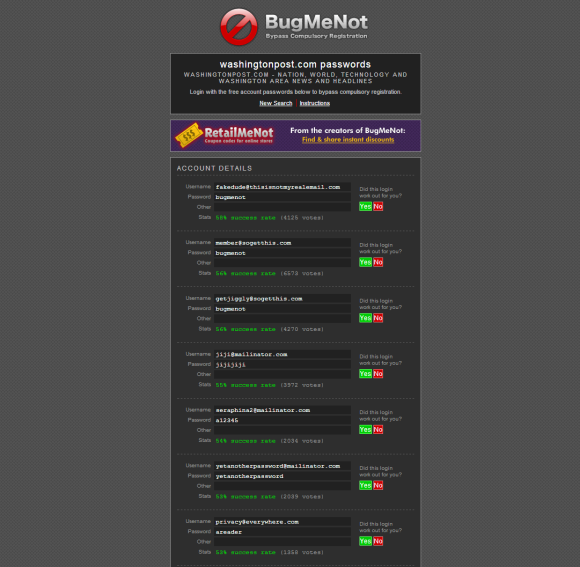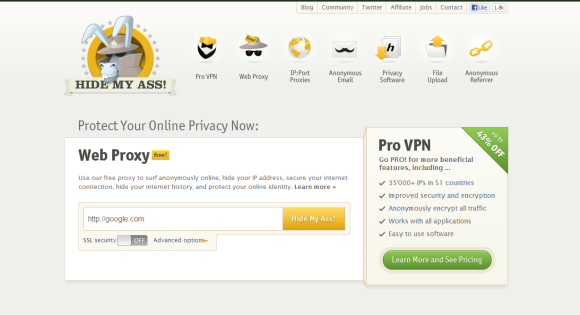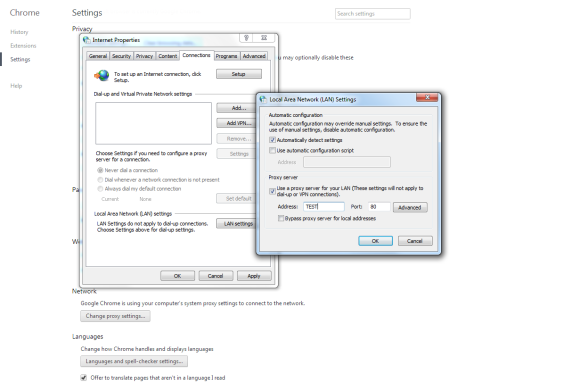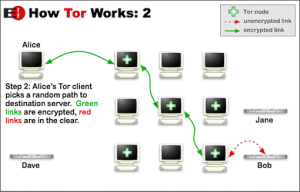They say no one can hear you scream in space, but if you so much as whisper on the Web, you can be tracked by a dozen different organizations and recorded for posterity. Simply visiting a website can allow its operators to figure out your general physical location, identify details about your device information, and install advertising cookies that can track your movements around the web. (Don't believe me? Check this out.)
Not everyone likes the idea of having his or her entire digital lives scraped, analyzed and (in countries with restrictive regimes) controlled outright by third parties. So please consider the following tools and tips, which will hide your IP address and have you surfing the web in blissful anonymity in no time.
Knowing is half the battle
There are a few crucial tidbits you should know before you start down the path to online anonymity. First, it's important to know how anonymizing proxies work so you can understand their inherent flaws. Anonymizers act as a man in the middle while you're browsing the web, handling communications between your PC and the website you want to access anonymously. If you do everything correctly, the target website only sees information from the anonymizing service, so it can't identify your home IP address or other personal information.
While the websites that you're browsing won't have any idea who you are, the man-in-the-middle anonymizing services certainly will (and some proxy services keep server logs of user activity that can be subpoenaed). For these reasons, it's important to do your research before you pick a proxy service.
Furthermore, websites can access data stored by browser plugins to try and track down your actual IP address. Media-playing plugins such as Flash are notorious for passing along more user data than is necessary, so stick to a plugin-free browsing experience if you're concerned about third-party programs sharing information about you or your PC.
Speaking of browsers, you might want to set aside a second browser on your PC that you use solely for your anonymous activities. Most anonymizer services still allow websites to place cookies on your computer by default, and if you use the same browser for both everyday activities and the browsing you want to keep anonymous, websites could theoretically use those cookies to identify you.
To avoid this, download a second web browser (Chrome and Firefox are great choices) and change your anonymous browser's settings to wipe cookies every time you close the browser. If you're worried about local users snooping on your Internet exploits, be sure to use your browser's Private or Incognito mode so anyone who opens your browser won't be able to check the history and see where you've been.
Finally, this probably doesn't need to be said, but if you log into a website using a username/password combination, the website administrators can track you regardless of whether you're using an anonymizer service. If you need to log in to a website to tap into its full features, see if BugMeNot has a generic login available for the site.
Got it? Good! Let's dig into the various anonymizing tools at your disposal.
Web proxies
The most basic way to surf websites anonymously is by using web-based proxies likeProxify, Anonymouse or Hide My Ass. Web proxies are simple and easy to use: Just head to the anonymizing website, type in the URL of the website you want to visit anonymously, and you're off! Some even include advanced features like the ability to encrypt your connection or block ads, cookies, and JavaScript.
Web proxies may be straightforward (and often free), but they have several drawbacks. Data speeds can be atrocious, certain types of content (videos, music, etc.) may be difficult to access, many proxy services interject their own advertising, and some websites simply won't work through a proxy.
Also, while free web proxies are a dime a dozen and new ones pop up on an almost hourly basis, it's difficult to tell which ones are honeypots set up by bad guys hoping to sneak a peek at your personal information as you share it through their proxy server. In other words, you shouldn't do your online banking or log into a password-protected website when you're using a web proxy—especially if the connection isn't encrypted vita HTTP Secure (denoted by an https:// prefix in your browser's address bar).
The three web proxies identified above are long-standing and well-trusted, however, and each offers a paid subscriber service that nixes the speed and content complaints.Proxy.org and PublicProxyServers.com also maintain extensive, frequently updated lists of web proxies.
Manual proxy servers
Some proxy servers don't have a simple website interface, but still allow you to utilize their service for anonymous browsing. You just need to manually configure your browser to connect to the proxy's IP address. As with web-based proxies, you'll want to shy away from revealing sensitive information or passwords with a proxy server.
Hide My Ass and ProxyNova keep two of the best lists of active proxy servers, with each individual proxy's speed, uptime, country of origin and level of anonymity clearly identified. (You want an anonymous or high anonymous proxy server, of course.)
Once you've picked a proxy server, you'll need to configure your browser to connect to it, a simple procedure that's slightly different depending on your browser. Here's how to do it on the big three:
Internet Explorer 9: Navigate to Tools > Internet Options > Connections tab > LAN Settings. Check the Use a proxy server box and enter the port and IP address info for the proxy server, then click OK. If the proxy you chose uses a secure or SOCKS connection rather than HTTP, enter the settings in the Advanced option.
Firefox: Click on the Firefox button and navigate from Options > Advanced Tab > Network Tab, then hit the Settings button in Connections.
Chrome: Click the Wrench icon choose Show Advanced Settings > Change Proxy Settings, then simply proceed as you would with Internet Explorer.
Hide your IP address with a VPN
Virtual Private Networks are a good option for people who want an anonymous yet speedy connection and don't mind paying for the privilege. Premium VPNs maintain dedicated proxy servers for their users. Your connection is encrypted and the websites you visit see the VPN's identifying information, not your own.
There are a ton of VPNs out there, and virtually all of them block your identity from third-party websites, but the question an anonymous-minded person wants to ask is, Does my VPN provider keep server logs? TorrentFreak asked several top VPNs that very questionand several answered with a resounding "No!" Once you've settled on a provider, you'll need to configure Windows 7 to connect to the VPN.
One of the best and most well-known virtual private networks is The Onion Router, or Tor for short. The Tor network has proven its mettle under fire, helping journalists file reports from countries where Internet access is restricted and allowing citizens to communicate digitally when governments shut down the Internet. Rather than establishing a direct connection between your PC and a proxy server, then connecting the proxy server to the website you want to visit, Tor bounces your data request through several random Tor server relays before pointing it to the final destination. In fact, Tor got its name because like an onion (or an ogre), this network has layers.
The server at each of those layers only knows the identity of the relay that passed it information and the relay it subsequently passes that information along to, with each hop in the chain being encrypted with a totally new encryption key. The robust security measures mean that even if someone is able to intercept one of the data packets en route and crack the encryption, they won't be able to identify you or your final destination. New relay paths are randomly generated every ten minutes or so.
It sounds complicated, but tapping into Tor couldn't be easier. Simply download the Tor Browser Bundle for your operating system of choice (there's even an Android version) and boot up the browser file when you want to surf anonymously. The program handles all the dirty work automatically and even goes so far as establishing an HTTPS connection at your final destination if it's possible. But if you're feeling particularly vulnerable, you can right-click on the Vidalia onion icon in your system tray and select New Identity to tell the browser to create a new relay server path.
The Tor Browser doesn't require installation and can be run from a flash drive if you want to carry a copy with you.
Send email anonymously
Now that you know how to cloak your online activities from prying eyes, here's a bonus tip for sending email anonymously for free. See, most of the anonymizers outlined above only play nice with web browsing, but Anonymouse and Hide My Ass both offer free, basic anonymous email services. The recipient won't know your IP address, actual email address or any other personally identifiable information. With these tips and tools you should be well-equipped to improve your online anonymity; be sure to share your tips with other readers in the comments section and enjoy a safe browsing experience
http://www.pcworld.com/article/2013534/how-and-why-to-surf-the-web-in-secret.html







Obat mata minus
ReplyDeleteSehat mata softgel
http://ow.ly/AbjX30f2TzI
http://mysp.ac/3u1Iz
Walatra sehat mata
Obat mata minus walatra
Qnc Jelly Gamat
ReplyDeletehttp://goo.gl/Gfxa1w
http://mysp.ac/3ulsk
http://bit.ly/2xqlG0Y
http://ow.ly/eEC730fphtf
http://tinyurl.com/y97c7uth